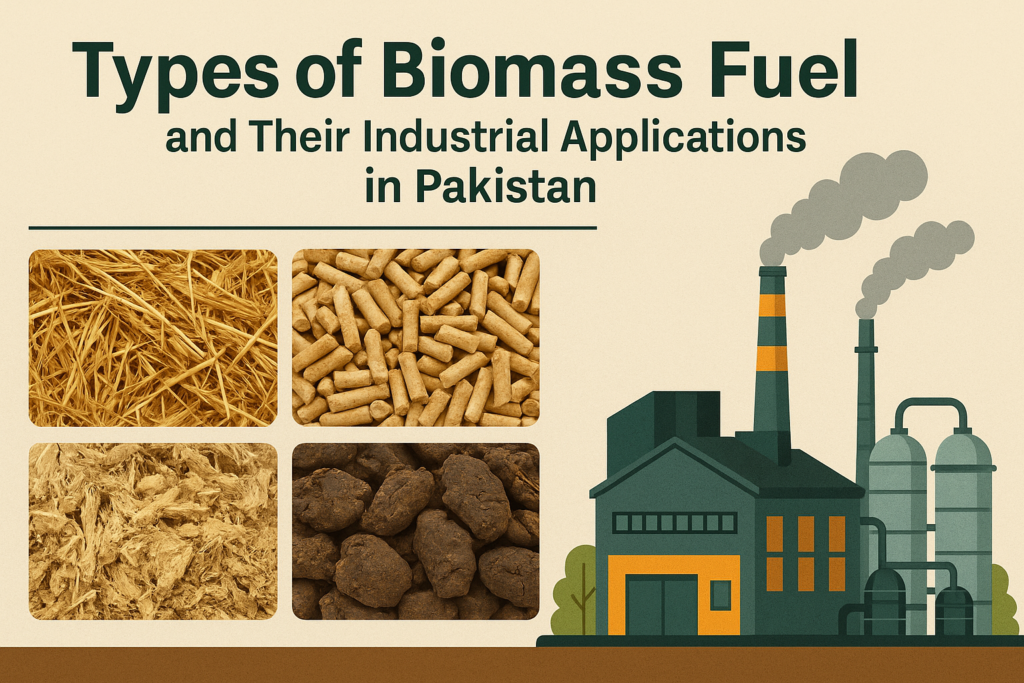
Introduction
Biomass has emerged as a sustainable and renewable energy source across the globe, including Pakistan. The country faces increasing energy demands, reliance on imported fossil fuels, and environmental concerns, making biomass an attractive solution. Biomass fuel refers to organic materials derived from plants, agricultural waste, forestry residues, and even animal dung, which can be converted into energy. Pakistan, being an agrarian economy, generates millions of tons of agricultural and forestry by-products annually, offering significant opportunities for biomass utilization.
This article explores the types of biomass fuel, their industrial applications in Pakistan, current usage patterns, import-export potential, and future prospects.
Types of Biomass Fuel
Biomass fuels can be categorized into several types, each with distinct characteristics and industrial applications. In Pakistan, the following biomass fuels are most commonly available:
1. Agricultural Residues
- Examples: Wheat straw, rice husk, corn cobs, sugarcane bagasse, cotton stalks.
- Availability in Pakistan: Pakistan produces over 100 million tons of crop residues annually.
- Uses: Direct combustion for heat and power generation, production of bio-pellets, and biochar.
2. Forestry Residues
- Examples: Wood chips, sawdust, tree branches, and logging waste.
- Uses: Co-firing in power plants, briquettes for domestic and industrial heating, and feedstock for biofuel production.
3. Animal Waste
- Examples: Cow dung, poultry litter, and goat/sheep manure.
- Uses: Anaerobic digestion to produce biogas, which is used for electricity generation, heating, and cooking.
4. Energy Crops
- Examples: Jatropha, switchgrass, miscanthus, and fast-growing trees.
- Uses: Dedicated cultivation for biofuel production, ethanol, and biodiesel.
5. Industrial Organic Waste
- Examples: Food processing waste, paper industry residues, and textile sludge.
- Uses: Anaerobic digestion, composting, and incineration for heat and energy.
6. Municipal Solid Waste (MSW)
- Examples: Organic fraction of household and market waste.
- Uses: Waste-to-energy plants, RDF (Refuse Derived Fuel), and gasification.
Industrial Applications of Biomass in Pakistan
Biomass is not only a renewable energy source but also plays a significant role in industrial sectors. The table below highlights industrial applications:
| Industry | Biomass Fuel Used | Application |
|---|---|---|
| Power Generation | Bagasse, rice husk, MSW | Biomass-based power plants, co-firing with coal |
| Textile Industry | Rice husk, wood chips | Steam generation for boilers, heating applications |
| Cement Industry | Refuse Derived Fuel (RDF) | Alternative to coal in kilns |
| Paper and Pulp Industry | Wood residues, black liquor | Energy recovery, self-sustained power generation |
| Food Processing Industry | Agro-residues, biogas | Heating, drying, power generation |
| Domestic/Commercial Use | Biogas, briquettes | Cooking, heating, rural electrification |
Biomass Energy Potential in Pakistan
Pakistan’s biomass energy potential is enormous due to its agricultural base. Estimates suggest that biomass can generate over 50,000 MW of electricity, if fully utilized.
Key Biomass Resources in Pakistan:
- Sugarcane Bagasse: 4.5 million tons annually (used in sugar mills for co-generation).
- Rice Husk: 6 million tons annually.
- Cotton Stalks: 10 million tons annually.
- Animal Manure: Over 100 million tons annually.
Biomass Import and Export in Pakistan
While Pakistan produces abundant biomass, the structured market for biomass fuel (pellets, briquettes, and biochar) is still developing.
Biomass Imports:
- Import of specialized biomass boilers and gasification plants.
- Import of bio-pellets in limited quantities for industrial trials.
Biomass Exports:
- Pakistan exports rice husk pellets and cotton stalk briquettes to countries like China and UAE.
- Potential markets: Europe (due to strict carbon neutrality goals), Gulf countries (for biomass-based energy diversification).
| Biomass Product | Export Destinations | Annual Export Volume |
| Rice Husk Pellets | China, UAE | 50,000 tons |
| Cotton Stalk Briquettes | Middle East | 20,000 tons |
| Biomass Charcoal | Europe, GCC | 10,000 tons |
Challenges in Biomass Utilization in Pakistan
Despite the huge potential, the biomass sector faces several challenges:
- Lack of Infrastructure: Limited biomass collection and supply chain.
- Technology Gap: Dependence on imported biomass processing machinery.
- Awareness Issues: Farmers and industries are often unaware of biomass’s economic benefits.
- Policy Barriers: Inconsistent renewable energy policies hinder biomass investments.
Future Prospects of Biomass in Pakistan
- Biogas Plants: Expansion of community-based and industrial biogas plants.
- Bio-Pellets Industry: Growing export market for compressed biomass products.
- Co-Firing in Power Plants: Substitution of imported coal with local biomass.
- Government Support: Incentives for renewable energy investments can boost the biomass sector.
- Rural Electrification: Off-grid communities can rely on biomass-based microgrids.
Conclusion
Biomass represents one of the most promising renewable energy solutions for Pakistan. With abundant agricultural and forestry residues, animal waste, and municipal organic waste, Pakistan has the resources to significantly reduce its dependency on imported fossil fuels. Industrial applications in power generation, textiles, cement, and food processing already demonstrate its potential. By developing a structured biomass market, enhancing technology adoption, and facilitating exports, Pakistan can position itself as a regional leader in biomass energy.
If properly managed, biomass can not only fulfill a significant share of Pakistan’s energy demand but also contribute to environmental sustainability, rural development, and economic growth.







Leave a Reply